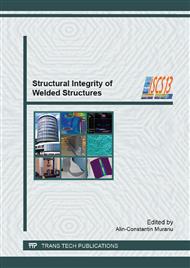p.141
p.147
p.159
p.165
p.173
p.180
p.187
p.193
p.207
The Improvement of the Physical and Mechanical Properties of Steel Deposits Obtained by Thermal Spraying in Electric Arc
Abstract:
Steel depositsobtained by thermal spray arc have physical-chemical and mechanical properties dependent on operational parameters of the spraying process. Thus, the electric current intensity, the spray distance, the velocity, respectively the driving gas pressure are the parameters that influence the mechanical properties of the steel deposits obtained by thermal spraying. The interaction between particles- gas drive seen in the classic arc spray has the effect the lowering of particles temperature and implicitly of the physical and mechanical properties of the deposit. Using a new device, combined, in which over the thermal field, created by the electric arc, would overlap a second thermal field, created by a gaseous fuel burning, would determine the maintaining of high temperature of the particles and implicitly changes of the physical, chemical and mechanical properties of the deposit. Such a combined spraying device would be called device for spraying in electric arc-thermally activated. The paper aims to present a comparative study of the physic chemical and mechanical properties of steel deposits obtained with two spraying processes: the classical process and the combined spraying process - in electric arc thermally activated.Investigations carried out on the structure of deposits by electron microscopy SEM, XRD analysis and image analysis performed at zone level Layer-Substrate as well the deposits adherence assessment in accordance with EN 582-allows the highlighting properties, the arguing of differences between the properties of the deposits made by the two methods as well as the establishing advantages and disadvantages using those processes.
Info:
Periodical:
Pages:
173-179
Citation:
Online since:
September 2013
Keywords:
Price:
Сopyright:
© 2013 Trans Tech Publications Ltd. All Rights Reserved
Share:
Citation:


